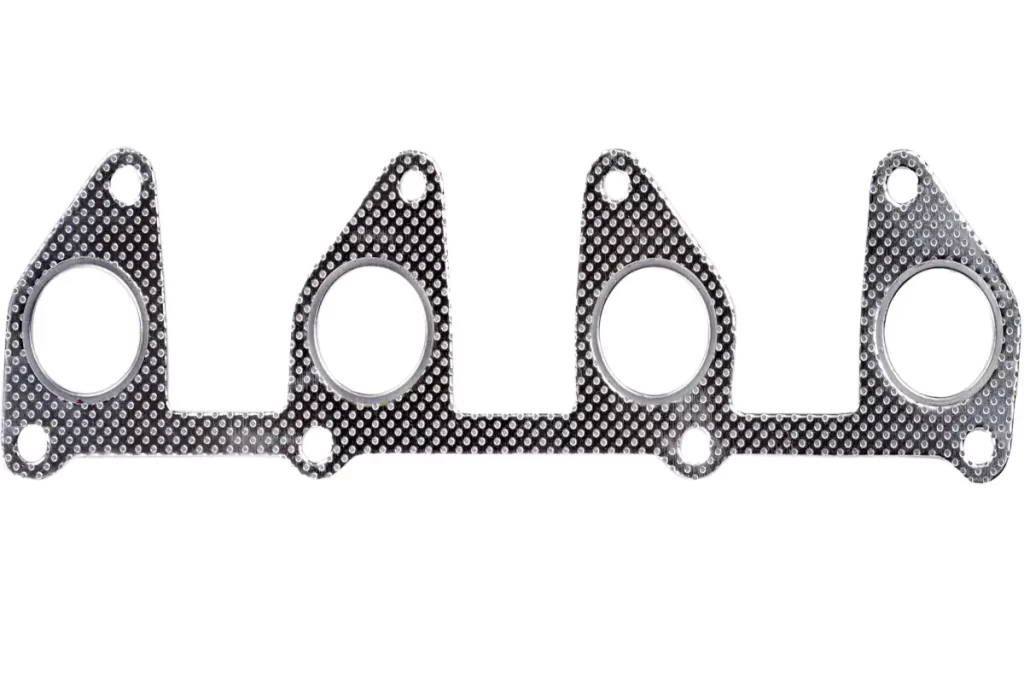Installing an exhaust manifold gasket on an exhaust manifold can be tricky because you aren’t sure which way to install it.
Some are marked clearly to help make installation easier and others may look identical on both sides.
You can sometimes find instructions with the gasket or on the manufacturer’s website.
What is the best way to install a gasket when you don’t know which way it should face?
Here’s The Correct Way For Exhaust Manifold Gaskets To Go
Most gaskets, such as heads and intake manifolds, have directional markings to guide installation when the orientation of the gasket is crucial. In order to understand what front, left, right, top, and up mean on gaskets, you have to understand car lingo even if you have the instruction manual with you. The direction (left or right) of installation is usually referenced from the driver’s point of view and that is the correct way.

There is a variety of wording used by different part manufacturers in their OE service manuals for directional marking; many gaskets refer to their nameplates when providing repair information.
There can still be a problem determining which way to install a gasket, even when it has directional markings or nameplates.
In what part of the engine is the front? In front-wheel drive vehicles, which have transversely mounted engines, this can be confusing. In essence, the drive belts are located at the front of the engine.
According to industry standards, right and left are calculated from the driver’s viewpoint.
The gaskets would be installed incorrectly if you were to look at the engine from the front of the vehicle and install them on the left and right sides.
In order to install the gasket properly, it should face you from the top or up. Gaskets for head gaskets or intake manifolds sometimes lack directional indicators.
They may be coated or colored differently. The direction in which the gasket is installed does not matter in these cases. There would be a mark on it if it were crucial.
A smooth, metallic side should be installed toward the exhaust manifold when installing exhaust manifold gaskets with a composite side. During heat cycling caused by engine operation, the flange of the exhaust manifold will slide across the smooth surface of the shiny side.
Related:
- Are Car Exhaust Manifold Gaskets Reusable? (Explained For Beginners)
- What Is The Purpose Of Exhaust Manifolds In A Car? (Explained)
- Is A Car Exhaust Manifold Heat Shield Necessary? (3 Signs Of Damage)
How Do You Know Which Way Is The Correct Way To Install Exhaust Manifold Gaskets?
Many exhaust manifolds come with instructions but this is not the case for all of them.
Some do come with covers or coating on one side that can be peeled off before installation and show directions on the gasket that should be installed. On some models or with some gaskets, there is no specific way to install the gasket.
Some work no matter how they are installed. If you look at the gasket closely, you will be able to tell if there is one side that is different from the other. If both sides look to be the same, you may be able to install the gasket in any direction.
If you can tell that one side is different, check to see if there are any directional instructions or words that may suggest the right way to do it.
If there are no obvious signs that tell you how to install the gasket or if you can’t figure it out, you may be able to check the website of the gasket manufacturer to determine if there are any directions available.
Some websites offer manuals and guides to make it easier to install the parts.
What Happens If I Installed The Exhaust Manifold The Wrong Way?
If you install the exhaust gasket backward or the wrong way, there’s always a chance that there could be a leak. A leak can result in performance problems and either make the vehicle run slow, reduce gas mileage, or cause other issues. Some common issues include,
Loud Sounds
You’ll probably notice that your car sounds louder than usual when you have an exhaust leak. You will see a few mufflers on your exhaust pipe that greatly reduce engine noise.
Those mufflers aren’t going to silence the sound of the exhaust leak if it occurs before one of them. According to the size of the exhaust leak, there will be a higher engine sound.
Check Engine Light
There are sensors installed near the tailpipe of modern cars for measuring the fuel mixture leaving the engine. Catalytic converter efficiency is also measured by one of these sensors. They are called Oxygen Sensors or O2 Sensors.
The engine control unit will recognize faulty readings if there is an exhaust leak before one of these sensors. Your dashboard will display the check engine light as a result.
Engine Problems
In this case, as well, the check engine light should be turned off. A leak in an exhaust pipe will cause these sensors to get false readings, which will cause the engine control unit to send false information.
When these values are incorrect, the engine control unit will calculate the wrong air-fuel mixture for the next cycle in the car engine, creating even more strange air-fuel mixtures. It can lead to rough idles, slow accelerations, rough accelerations, and misfires.
Can I Reuse The Exhaust Manifold Gasket That Was Installed Incorrectly?
You may be able to reuse the gasket, depending on the vehicle, the condition of the gasket, and how long it has been on the car.
If you own a relatively new car, you can always reuse the exhaust gaskets since they are in great shape.
For older cars, however, it’s important to avoid reusing exhaust gaskets. A gasket on an exhaust system typically wears out over time.
A worn exhaust gasket is highly likely to occur in vehicles with long-term use of the same exhaust gasket.
Check out this excellent article on resuing exhaust manifold gaskets, Are Car Exhaust Manifold Gaskets Reusable? (Explained For Beginners)
Only 100,000 miles can be logged on an exhaust gasket before it can be reused. Replacement of gaskets should be carried out as soon as possible after that time period has elapsed. A gasket needs to be replaced sooner rather than later, however.
A complete inspection of the gaskets and other exhaust system components should be inspected during every service. Gaskets should not be reused if they have less than 100K miles on them.
The wear life of a particular gasket may be shorter than that of others. No matter what, you shouldn’t reuse exhaust gaskets.
In terms of the cost of exhaust gaskets, they are usually very affordable. Most are under $20. As important as this part may appear, it’s not expensive.
There are many auto parts stores that sell exhaust gaskets that have affordable prices and are also easy to find.
You can get a new gasket at your nearest auto store if you don’t want to order one online.
Conclusion
Some manifold gaskets are marked with a colored film or a directional marking that tells you which way to install them. Others are universal or are made in a way that they can be installed with either side facing up.
Check the instructions that come with the specific gasket you buy as well as the manufacturer’s website if you need help determining how to install the gasket so it faces the right direction.
While there is no serious harm that can come from installing the gasket backward, there are some issues that may occur and affect your car’s performance.



